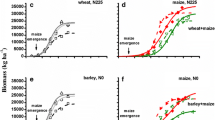Summary
Grain yield and its endpoint components were studied for three barley varieties, Dayton, Hudson, and Tenn 60-34, as pure stands and two-way and three-way mixtures at three widely separated sites for two years. The populations, including the pure stands, produced similar grain yields. Complementary competition was observed in all mixed populations in which Tenn 60-34 occurred. Its yield was suppressed in mixtures about 20% while Dayton and Hudson increased a like amount so that total mixed population yield was equal to that expected from pure stand performance. Tenn 60-34 occurred at 33, 50, and 80% frequencies in mixed populations with no difference in competition, indicating a lack of frequency dependency for the effect.
Yield component data indicated that the reduced yield of Tenn 60-34 in mixed stands was due entirely to a decreased number of spikes produced per unit area. It was inferred that this was due to competition at time of tillering although this could not be determined since the varieties were indistinguishable during vegetative growth.
An examination of population-environment interaction provided some evidence for the idea that heterogeneous populations in which there is intense competition show greater micro-environment (within-site) instability. Heterogeneous populations generally showed lower than expected contribution to the population-environment variance although the differences were quite small.
These results have important implications for the utilization of heterogeneous populations in agricultural production and for the management of genetically diverse populations in plant breeding practice since genotypic frequencies are expected to change rapidly with complementary competition.
Similar content being viewed by others
References
Allard, R. W., 1961. Relationships between genetic diversity and consistency of performance in different environments. Crop Sci. 1: 127–133.
Allard, R. W. & Adams, J., 1968. The role of intergenotypic interactions in plant breeding. Proc. XII Int. Cong. Genetics 3: 349–370.
Allard, R. W. & Adams, J., 1969. Population studies in predominantly self-pollinating species. XII. Intergenotypic competition and population structure in barley and wheat. Am. Nat. 103: 621–645.
Allard, R. W. & Bradshaw, A. D., 1964. Implications of genotype-environmental interactions in applied plant breeding. Crop Sci. 4: 503–508.
Clay, R. E. & Allard, R. W., 1969. A comparison of the performance of homogeneous and heterogeneous barley populations. Crop Sci. 9: 407–412.
Edwards, K. J. R. & Allard, R. W., 1963. The influence of light intensity on competitive ability. Am. Nat. 97: 243–248.
Frey, K. J. & Maldonado, U., 1967. Relative productivity of homogeneous and heterogeneous oat cultivars in optimum and suboptimum environments. Crop Sci. 7: 532–535.
Hanson, W. D., 1964. Genotype-environment interaction concepts for field experimentation. Biometrics 20: 540–552.
Harlan, H. V. & Martini, Mary, L., 1938. The effect of natural selection in a mixture of barley varieties. J. agric. Res. 57: 189–199.
Harper, J. L., 1964. The nature and consequences of interference amongst plants. Proc. XI Int. Cong. Genet. 2: 465–482.
Hartmann, R. W. & Allard, R. W., 1964. Effect of nutrient and moisture levels on competitive ability in barley (Hordeum vulgare L.). Crop Sci. 4: 424–426.
Jennings, P. R. & de Jesus, J., 1968. Studies on competition in rice. I. Competition in mixtures of varieties. Evolution 22: 119–124.
Jennings, P. R. & Aquino, R. C., 1968. Studies on competition in rice. III. The mechanism of competition among phenotypes. Evolution 22: 529–542.
Jennings, P. R. & Herrara, R. M., 1968. Studies on competition in rice. II. Competition in segregating populations. Evolution 22: 332–336.
Jensen, N. F., 1952. Intra-varietal diversification in oat breeding. Agron. J. 44: 30–34.
Jensen, N. F., 1965. Multiline superiority in cereals. Crop Sci. 5: 566–568.
Lee, J. A., 1960. A study of plant competition in relation to development. Evolution 14: 18–28.
Pfahler, P. L., 1964. Fitness and variability in fitness in the cultivated species of Avena. Crop Sci. 4: 29–31.
Pfahler, P. L., 1965a. Environmental variability and genetic diversity within populations of oats (cultivated species of Avena) and rye (Secale cereale L.). Crop Sci. 5: 271–275.
Pfahler, P. L., 1965b. Genetic diversity for environmental variability within the cultivated species of Avena. Crop Sci. 5: 47–50.
Qualset, C. O., 1968. Population structure and performance in wheat. Proc. Third Int. Wheat Genetics Symp. Aust. Acad. Sci. 397–402.
Qualset, C. O. & Granger, R. M., 1970. Frequency dependent stability of performance in oats. Crop Sci. 10: 386–389.
Rasmusson, D. C., 1968. Yield and stability of yield of barley populations. Crop Sci. 8: 600–602.
Sakai, K. I., 1955. Competition in plants and its relation to selection. Cold Spring Harb. Symp. Quant. Biol. 20: 137–157.
Schutz, W. M., Brim, C. A. & Usanis, S. A., 1968. Inter-genotypic competition in plant populations I. Feedback systems with stable equilibria in populations of autogamous homozygous lines. Crop Sci. 8: 61–66.
Simmonds, N. W., 1962. Variability in crop plants, its use and conservation. Biol. Rev. 37: 422–465.
Suneson, C. A., 1949. Survival of four barley varieties in a mixture. Agron. J. 41: 459–461.
Suneson, C. A. & Wiebe, G. A., 1942. Survival of barley and wheat varieties in mixtures. J. Am. Soc. Agron. 34: 1052–1056.
Wricke, G., 1962. Uber eine Methode zur Erfassung der ökologische Streubreiten in Feldversuchen Z. Pfl. Zücht. 47: 92–96.
Author information
Authors and Affiliations
Rights and permissions
About this article
Cite this article
Early, H.L., Qualset, C.O. Complementary competition in cultivated barley (Hordeum vulgare L.). Euphytica 20, 400–409 (1971). https://doi.org/10.1007/BF00035665
Received:
Issue Date:
DOI: https://doi.org/10.1007/BF00035665




